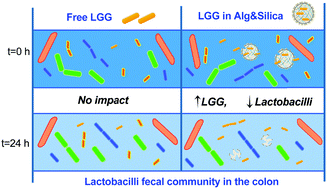当前位置:
X-MOL 学术
›
J. Mater. Chem. B
›
论文详情
Our official English website, www.x-mol.net, welcomes your
feedback! (Note: you will need to create a separate account there.)
Original behavior of L. rhamnosus GG encapsulated in freeze-dried alginate–silica microparticles revealed under simulated gastrointestinal conditions
Journal of Materials Chemistry B ( IF 6.1 ) Pub Date : 2017-09-06 00:00:00 , DOI: 10.1039/c7tb02190a Fernanda B. Haffner 1, 2, 3, 4 , Tom van de Wiele 5, 6, 7, 8 , Andreea Pasc 1, 2, 3, 4
Journal of Materials Chemistry B ( IF 6.1 ) Pub Date : 2017-09-06 00:00:00 , DOI: 10.1039/c7tb02190a Fernanda B. Haffner 1, 2, 3, 4 , Tom van de Wiele 5, 6, 7, 8 , Andreea Pasc 1, 2, 3, 4
Affiliation

|
The probiotic bacteria L. rhamnosus GG (LGG) were encapsulated into core–shell alginate–silica microbeads of about 500 μm through a double step synthesis involving micro-ionogel formation by electrospraying and silica coating by the sol–gel process. Formulating microparticles with sucrose as a cryoprotectant allowed maintaining bacterial viability and cultivability upon freeze-drying for weeks, as determined by plate counting. As much as 3.4 × 1010 CFU g−1 and 4.1 × 108 CFU g−1 were observed to be cultivable in alginate and silica-coated beads after 3 weeks of freeze-drying, respectively. The viability of the released bacteria was evaluated in an in vitro batch SHIME model (a simulator of the human intestinal microbial ecosystem) by denaturing gradient gel electrophoresis (DGGE) and quantitative PCR (qPCR). It was revealed that microencapsulation efficiently protects LGG from the low gastric pH, especially in the case of silica-coated beads. Both encapsulation systems (alginate and alginate–silica) allowed for a better colonization of the colon compared with free LGG. Interestingly, although metabolically inactive in the upper digestive tract, LGG released from silica-coated beads boost their metabolism once they arrive in the colon, where they outcompete other members from the Lactobacillus community. In view of these results, we show that silica, usually used as an anti-caking agent in food powders, can play an active role in probiotics delivery and colon colonization.
中文翻译:

沙门氏菌GG包裹在冻干藻酸盐-二氧化硅微粒中的原始行为在模拟胃肠道条件下显示
益生菌鼠李糖乳杆菌GG(LGG)通过双步合成过程被封装到约500μm的核-壳藻酸盐-二氧化硅微珠中,该过程涉及通过电喷雾形成微离子凝胶和通过溶胶-凝胶工艺形成二氧化硅涂层。用蔗糖作为冷冻保护剂配制微粒,可以保持细菌的活力和冷冻干燥数周后的可培养性,这通过平板计数来确定。冷冻干燥3周后,在藻酸盐和二氧化硅包被的珠粒中分别可培养多达3.4×10 10 CFU g -1和4.1×10 8 CFU g -1。在体外评估释放细菌的生存力变性梯度凝胶电泳(DGGE)和定量PCR(qPCR)批量SHIME模型(人类肠道微生物生态系统的模拟器)。结果表明,微囊化可有效保护LGG免受低胃液pH的影响,尤其是在二氧化硅包被的微珠的情况下。与自由LGG相比,两种包封系统(藻酸盐和藻酸盐-二氧化硅)均能使结肠更好地定殖。有趣的是,尽管在上消化道中无代谢活性,但从二氧化硅涂层的珠子释放的LGG到达结肠后,便会增强其新陈代谢,从而在竞争中胜过乳酸杆菌的其他成员。社区。鉴于这些结果,我们表明通常在食品粉中用作抗结块剂的二氧化硅可在益生菌传递和结肠定植中发挥积极作用。
更新日期:2017-09-22
中文翻译:

沙门氏菌GG包裹在冻干藻酸盐-二氧化硅微粒中的原始行为在模拟胃肠道条件下显示
益生菌鼠李糖乳杆菌GG(LGG)通过双步合成过程被封装到约500μm的核-壳藻酸盐-二氧化硅微珠中,该过程涉及通过电喷雾形成微离子凝胶和通过溶胶-凝胶工艺形成二氧化硅涂层。用蔗糖作为冷冻保护剂配制微粒,可以保持细菌的活力和冷冻干燥数周后的可培养性,这通过平板计数来确定。冷冻干燥3周后,在藻酸盐和二氧化硅包被的珠粒中分别可培养多达3.4×10 10 CFU g -1和4.1×10 8 CFU g -1。在体外评估释放细菌的生存力变性梯度凝胶电泳(DGGE)和定量PCR(qPCR)批量SHIME模型(人类肠道微生物生态系统的模拟器)。结果表明,微囊化可有效保护LGG免受低胃液pH的影响,尤其是在二氧化硅包被的微珠的情况下。与自由LGG相比,两种包封系统(藻酸盐和藻酸盐-二氧化硅)均能使结肠更好地定殖。有趣的是,尽管在上消化道中无代谢活性,但从二氧化硅涂层的珠子释放的LGG到达结肠后,便会增强其新陈代谢,从而在竞争中胜过乳酸杆菌的其他成员。社区。鉴于这些结果,我们表明通常在食品粉中用作抗结块剂的二氧化硅可在益生菌传递和结肠定植中发挥积极作用。











































 京公网安备 11010802027423号
京公网安备 11010802027423号